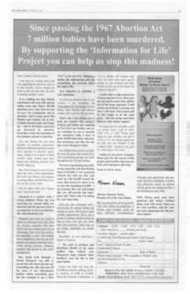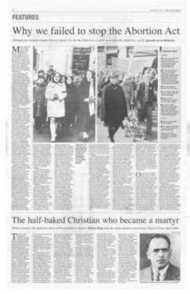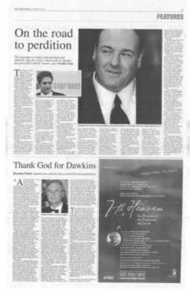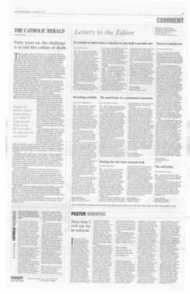Page 8, 26th October 2007
Page 8

Report an error
Noticed an error on this page?If you've noticed an error in this article please click here to report it.
Tags
Share
Related articles
The Day That We Took Franco At His Word
This Sad Loss Of Respect For Every Stable Institution,...
Accepting The Authority Of The Church
Anglican Dispute
Yes, The Church Is In Crisis
Why we failed to stop the Abortion Act
Although lay Catholics fought bravely against the Act the Church as a whole was tragically ineffective, recalls Quentin de la Bedoyere
Many readers will not recall the great debate leading up to the 1967 Abortion Act. Neither would I, had I not been marginally involved and retained a voluminous file. As this contains some 300 items, you will forgive me for only touching on the major issues. Nor can I insert many references or this article will be all references and no text. But first, a little history.
It is convenient to start with the Bourne Ruling (1938), when the existing right to abort to save the life of the mother was extended to her mental health — where continuing pregnancy threatened to make the woman "a physical or mental wreck". Using this ruling, and in particular the reference to mental health, a substantial industry in private legal abortions developed. One specialist was reported as charging about E4 million annually in today's currency. So you could get an abortion if you had the means and a sympathetic. or greedy, medical ear.
Not surprisingly, this led to strong social pressure to change the law so that abortions could be available to all. Why should only the rich have this facility? The main pressure group which stimulated the question (and gave the answer) was the Abortion Law Reform Association. This was a small but extremely influential organisation, intent on legalising abortion for social reasons. But, in addition to envy, the main emotional appeal was the number of illegal "backstreet" abortions to which the poor were restricted. The estimate of the number varied from 10,000 illegal abortions to 250,000, but 100,000 was a good round, frightening number and so it was popularly adopted — appearing again and again in the press. As a matter of interest, annual deaths from illegal abortions were around 20 a year, which would suggest that our backstreets must have been clinically clean and our criminal abortionists quite skilled.
A number of attempts to get Bills through Parliament had failed before David Steel introduced his Private Members Bill in July 1966. It was headed: "An Act to amend and clarify the law relating to termination of pregnancy by registered medical practitioners." The climate was right: Lord Silkin's recently abandoned Bill had received considerable support, the thalidomide tragedy was fresh in the public mind, and Roy Jenkins was an openly sympathetic Home Secretary who, although it was not a party matter, was prepared to give procedural assistance.
So the public argument mounted. You may gauge the complexity from one occasion when no less than 57 amendments had to be considered by Parliament. The main organised opposi tion came from the Society for the Protection of Unborn Children — a predominantly medically led organisation which, perhaps for tactical reasons, excluded Catholics from its committee although, ironically, Dr Aleck Bourne (of the Bourne Ruling) was a founder member. It appears to have had limited practical effect. ALRA, meanwhile, substituted "unwanted" for "unborn" in its public language.
The familiar arguments about the inherent rights of the foetus were aired but made little impression. Danger to the life of the pregnant woman had become almost irrelevant since medical advances had reduced its incidence to near invisibility.
Much was made in the general newspaper correspondence of doctors' anecdotal experiences of the shortand long-term outcomes of abortion. But the argument began to centre on the "Social Clause". This read "that the pregnant woman's capacity as a mother will be severely overstrained by the care of a child or of another child as the case may be". This was accompanied by a clause allowing abortion if the mother had conceived under the age of 16 or as a result of rape. Both these clauses were a new departure because they had no medical content. The British Medical Association and the Royal College of Obstetricians and Gynaecologists objected strongly, and Steel, to the annoyance of ALRA, withdrew them, judging that their retention might cause the whole Bill to fail. But the substituted clause had an unexpected effect. The new clause stated that a sufficient reason would be that the continuation of the pregnancy must involve greater danger to the mother or her existing children than an abortion, and that this judgment could take into account her actual or foreseeable environment, When ALRA heard this amendment, proposed in ignorance by an opponent of the Bill, they could scarcely restrain their joy. Diane Munday, a vigorous ALRA campaigner, told me that she nearly fell out of the parliatnentaty gallery with delight. They knew that abortion carried less risk than pregnancy to full Leon, and they had been presented with a highway to what was effectively abor tion on demand (although they had frequently claimed to me that this was not their objective). In practice nearly all abortions are carried out under this clause, which is virtually impossible to Another point at issue raised by the senior medical establishment was the need that a qualified consultant should be party to the medical recommendation, but this was rejected on the grounds that this was an unprecedented distinction between medically qualified people. It was thought sufficient that the operation be performed in an approved place.
In the background a number of opinion polls were commissioned by ALRA at intervals, and they showed an increasingly favourable view towards abortion in various circumstances. By February 1967 the percentage in favour was reaching 80 per cent, and sadly the proportion of Catholic support — at least for hard cases — was little lower than the general population. I am unable to confirm whether these polls were conducted face-to-face, but the samples were adequate and Diane Munday assured me that the questions were scrupulously neutral. The trend was unmistakable, and much was made of it. As for the Catholic campaign, there really wasn't one. The Hierarchy woke from their priedieux very late in the day, and, when they did, their few statements were weak and passed almost unnoticed. Far more work was done by the laity, both individuals and organisations like the Catholic Women's League. Even I tried to bring ALRA to open debate, either face to face or by a written, publishable exchange. I did not have the resources for the first, and they claimed they had no time for the second. As The Sunday Tunes put it: "Logic and scientific fact were not to play significant parts in the [Catholicj campaign." hi truth, our amateur attempts were in sharp contrast to those of the highly organised and mediasensitive ALRA.
In our recent conversation Diane Munday told me that she was originally motivated by the thalidomide incident, and believed strongly that the whole matter should be kept out of medical hands. But she was pleased to find that in practice many doctors took the initiative, although she disliked the fact that provision was geographically patchy, and often depended on the view of senior gynaecologists. Pregnancy advisory services were formed in order to solve this. Munday thought that the Catholic community was illogical — either you believed the foetus was a human or you didn't. Catholics often held the first position while inconsistently voting for abortion in hard cases. Her own view was, and remains, that rights came with "personhood", and that personhood status is only achieved by entry into society through birth. She is content in her belief that the effect of the Act has enabled illegal abortions to be replaced by legal ones.
0f course the opponents of the Bill were right. Within a year or two of the Act the number of abortions was rising steeply. Abortion on demand was coming about in practice. Many of the doctors who had laid claim to high medical ethics chose to become rubber-stamping conduits, and Harley Street was as rich as ever, while those who took their responsibilities seriously simply lacked the time to fulfil them. Abortion for physical or mental disabilities, which the guidance at the time suggested must amount to the child not being able to live an independent life, can now mean a harelip. The conscience clause in the Bill said nothing about protecting unwilling medical staff from discrimination in pay or promotional appointments.
Although my focus has been on the history of the debate rather than present circumstances it is interesting to read that a secular medical symposium published in 1969 was already noticing the trends. The development of an abortion pill was predicted, and the use of abortion as a means of contraception was expected. There was serious concern that medical practitioner agreement could he abused, leading to assembly-line abortions. Contributors regretted that simple lack of time precluded giving the counselling which might dissuade a woman under stress to reconsider her wish, and to save herself from its consequences.
Today there is a new campaign by Abortion Reform, into which ALRA was subsumed, advocating that the abortion decision in the first three months should now be solely in the hands of the woman. Once again the opinion polls are active, and show 77 per cent in favour, with only three per cent excluding abortion under all circumstances. And the campaign also demands "an end to minority anti-choice attacks on current abortion rights". We have been warned.
blog comments powered by Disqus

















